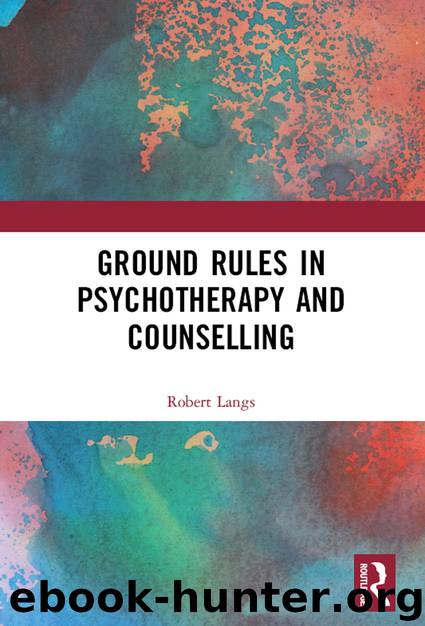Ground Rules in Psychotherapy and Counselling by Langs Robert;

Author:Langs, Robert;
Language: eng
Format: epub
Publisher: Routledge
The home-office
The home-office, whether an apartment or house, located within the therapist’s living quarters or separate from them, modifies the relative anonymity of the therapist and exposes his or her patients to family members—and the reverse. As a self-disclosure and breach of the total privacy and confidentiality of the therapy, this frame break creates a social and non-professional cast to the treatment.
This kind of frame modification is termed a vested-interest deviation (Langs, 1979), because the therapist modifies the frame largely for personal reasons in disregard for the therapeutic needs of his or her patients. This kind of frame modification is both seductive and destructive, and it functions for both patients and therapists as a maladaptive defence against separation, loss, and death anxiety. There is no sound reason for a therapist to use this kind of setting for his or her therapeutic work.
Vested-interest deviations are difficult to explore and even more difficult to resolve. Often, therapists naively follow their teachers or own therapists in making this choice of setting. The therapist who is committed to the deviation is also likely to become derivative-deaf with respect to patients’ encoded themes related to the deviant setting—their frame-related meanings will repeatedly be missed (Langs, 1982, 1992). Furthermore, patients tend unconsciously to protect their therapists from conscious guilt and conflict by avoiding this subject both manifestly and in their encoded narratives. This enables therapists who work in these deviant settings to continue to do so for long periods of time, seldom consciously aware of the damage that the setting is causing to their patients—and to themselves via the unconscious guilt that the hurtful aspects of the deviation evokes in them.
Typically, patients will not mention the modified setting even when there is an acute, frame-deviant incident, as, for example, when a patient sees or even talks to a therapist’s spouse or child. Most patients unconsciously restrict themselves to encoding a bridging and power theme or two in response to such incidents. These themes are easily missed by the therapist, in part because he or she is unaware of the acute triggering incident.
As a rule, the only time that these issues materialize with any consistency and in workable form is when a therapist decides to leave the home-office for a private, professional space. At such times, prior blatant incidents with family members and others are suddenly recalled by patients, and the unconscious meanings of these experiences finally appear in patients’ encoded themes in a manner that allows them to be linked to past and present triggers—and interpreted.
Because these settings unconsciously promote strong communicative defences that render many acute triggering events hidden from view and from therapeutic working through, these office arrangements are best avoided. The harm that they cause through negative introjects of the therapist’s unconscious anxieties and deviant modes of adaptation are such that the money a therapist saves in this way is poor compensation for the damage that they cause.
Mrs Jenkins was in therapy with Dr Hart, whose office was attached to his house. The
Download
This site does not store any files on its server. We only index and link to content provided by other sites. Please contact the content providers to delete copyright contents if any and email us, we'll remove relevant links or contents immediately.
Periodization Training for Sports by Tudor Bompa(7936)
Why We Sleep: Unlocking the Power of Sleep and Dreams by Matthew Walker(6376)
Paper Towns by Green John(4812)
The Immortal Life of Henrietta Lacks by Rebecca Skloot(4270)
The Sports Rules Book by Human Kinetics(4087)
Dynamic Alignment Through Imagery by Eric Franklin(3929)
ACSM's Complete Guide to Fitness & Health by ACSM(3830)
Kaplan MCAT Organic Chemistry Review: Created for MCAT 2015 (Kaplan Test Prep) by Kaplan(3812)
Introduction to Kinesiology by Shirl J. Hoffman(3633)
Livewired by David Eagleman(3541)
The River of Consciousness by Oliver Sacks(3425)
The Death of the Heart by Elizabeth Bowen(3348)
Alchemy and Alchemists by C. J. S. Thompson(3304)
Descartes' Error by Antonio Damasio(3168)
Bad Pharma by Ben Goldacre(3113)
The Emperor of All Maladies: A Biography of Cancer by Siddhartha Mukherjee(2941)
The Gene: An Intimate History by Siddhartha Mukherjee(2934)
The Fate of Rome: Climate, Disease, and the End of an Empire (The Princeton History of the Ancient World) by Kyle Harper(2884)
Kaplan MCAT Behavioral Sciences Review: Created for MCAT 2015 (Kaplan Test Prep) by Kaplan(2827)
